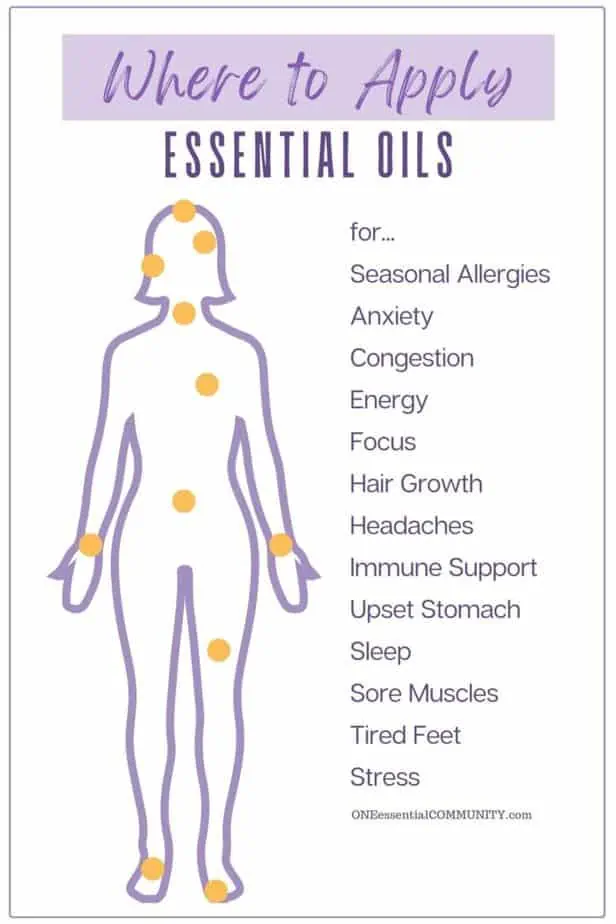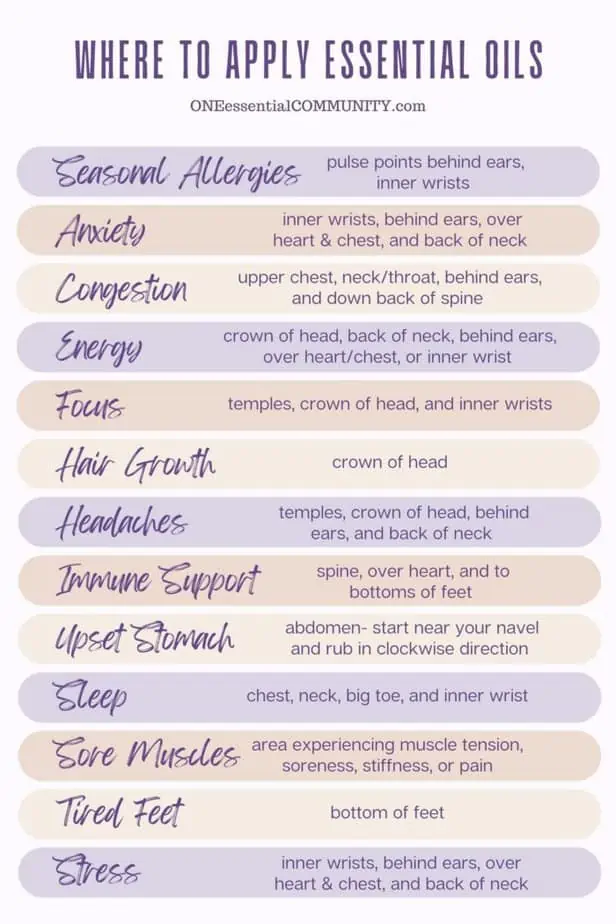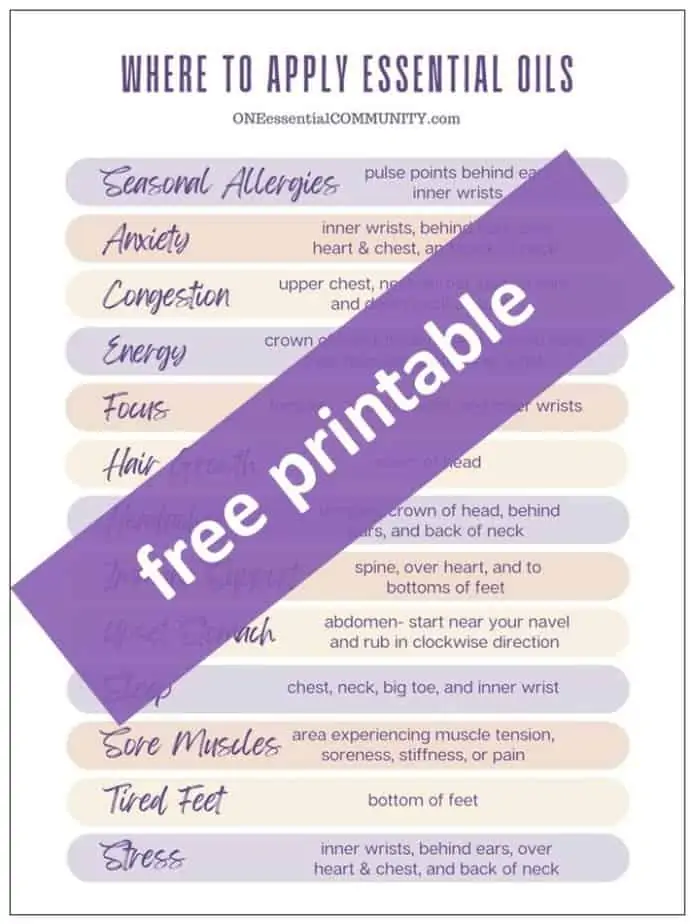When I first started using essential oils, I used a diffuser. I liked how good the essential oils made my house smell, and I loved the aromatherapeutic benefits I was experiencing, like lavender helping me sleep better at night, or peppermint helping soothe a headache. However, sometimes it is more beneficial to apply essential oils directly on the body, like when trying to ease an upset stomach or when treating thinning hair.
I needed to learn when to put essential oils on the body, where to apply them, and how to dilute oils properly so they are effective without causing harm.
In this post, I compiled a lot of things I’ve learned about applying essential oils topically, and in sharing some of my journey and I hope it assists you in yours.
Where Is the Best Place on the Body to Apply Essential Oils?
There is no single perfect place on the body to apply essential oils.
- If it’s a localized issue like stomachache or sore muscles, then apply the essential oils directly to the part of the body where the issue is occurring.
- However, if it’s a more generalized issue like lack of focus, trouble sleeping, or anxiety, then apply essential oils at your pulse points: wrists, temples, behind the ears, neck, chest, or inner elbow. Pulse points are the parts of the body where major arteries run closest to the skin. Applying essential oils at pulse points gets the essential oils into the bloodstream the fastest, and you start feeling the benefits of the essential oils sooner. This is because pulse points of the body are like roots of a plant. When feeding or watering a plant, you target the roots because that is where the plant absorbs nutrients and distributes them to the rest of the plant.
How Do You Apply Essential Oils Directly to the Skin?
When applying essential oils topically to skin, always dilute them with a carrier oil (such as, coconut oil, sweet almond oil, jojoba, or olive oil). Essential oils are very powerful, so it’s better to be safe than sorry.
In addition to diluting essential oils, I also do a skin patch test the first time I use an essential oil topically.
To do an essential oil patch test:
- Dilute the essential oil (in general 2-3 drops per teaspoon of carrier oil)
- Put a couple drops of that diluted essential oil on the inside of your elbow (skin is very thin here)
- Cover oil with a band-aid
- Wait 24-48 hours to see if there is a reaction (such as, redness, itchiness, inflammation, or pain)
- If no reaction occurs after elapsed time, then it’s generally safe to assume that you don’t have a sensitivity or allergy to that diluted essential oil and it’s safe to use.
- However, if reaction does occur (such as, redness, itchiness, inflammation, or pain), remove band-aid and gently wash skin to remove excess essential oil, then apply carrier oil (without any essential oils) to that same area of skin on inside elbow to further dilute any remaining essential oils.
- If you have a skin reaction, you have a few options:
- If reaction was mild, you may want to consider trying to dilute essential oil more and see if that works okay for you (such as only 1 drop of essential oil per teaspoon or two of carrier oils).
- Use a different essential oil as a substitute. There are many essential oils that have similar therapeutic benefits, so there’s bound to be one that works for your needs and doesn’t cause any reactions for you.
- Don’t use the essential oil topically and instead use it aromatically (such as, in a diffuser). Many times, essential oils that cause sensitivities to skin cause no negative reactions when used aromatically.
click here for a free printable of the essential oil application chart shown above
Where to Apply Essential Oils for Seasonal Allergies
When seasonal allergies flare up, apply essential oils to the pulse points behind your ears as well as your inner wrists. Then rub wrists together, raise wrists to just below your nose, and inhale deeply. By using both topical application and aromatherapy (breathing oils in), the essential oils will enter your bloodstream more quickly and your seasonal sneezing and itchy, watery eyes should lessen.
a few essential oils that help with seasonal allergies: lavender, lemon, peppermint
Are you ready to make this?
- Get my step-by-step instructions for how to make a rollerball blend for seasonal allergies here.
- In addition to topical application with a roller bottle, another great way to fight seasonal allergies is with a personal inhaler. You simply breathe in the essential oils and they go to work. Get my recipe and instructions for making a seasonal allergy inhaler here.
Where to Apply Essential Oils for Anxiety
If you’re feeling anxious or nervous, you can massage essential oil onto your inner wrists, behind your ears, over your heart and chest, and back of neck. These key pulse points will quickly take the essential oils where they need to go to help relieve anxiety and calm both your mind and body.
For additional calming support, put essential oil and carrier oil in palm of your hand, then rub palms together, cup hands over nose and mouth, and breathe in deeply. Breathe in for count of four, hold for four, and then exhale for count of four. Repeat as needed.
a few essential oils that help with anxiety: bergamot, lavender, sweet orange
Are you ready to make this?
- Get my step-by-step instructions for how to make a rollerball blend for anxiety here.
- In addition to topical application with a roller bottle, another great way to lessen anxious feelings is with a personal inhaler. You simply breathe in the essential oils and they go to work. Get my recipe and instructions for making an essential oil inhaler for anxiety here.
- And for something fun and unexpected make my homemade calming aromatherapy playdough. As you play with it, the scents of essential oils are released helping you to feel more calm and relaxed. It’s a great thing to use before bed or when you’re feeling a little stressed or anxious.
Where to Apply Essential Oils for Congestion
For stuffy, runny nose and congestion, massage diluted essential oils into upper chest, neck/throat, behind ears, and down back of spine. The topical application of essential oils, combined with the proximity of oils to nose and mouth, helps you breathe in the oils while they are also being absorbed in through your skin. This will help loosen mucus in your chest and nose, helping you to breathe clearer in no time.
a few essential oils that help with congestion: eucalyptus, peppermint, tea tree
Are you ready to make this?
- Find my recipe for homemade vapor rub here. It’s very easy to make and only takes two ingredients plus essential oils. Just like store-bought vapor rub, this DIY version is packed with cooling menthol to help open airways and ease coughs, but unlike the commercially made stuff, this is all natural and chemical free.
- Get my step-by-step instructions for how to make a rollerball blend for congestion here.
- In addition to topical application, diffusing essential oils for congestion is often very helpful. Get 25 of my favorite essential oil diffuser blends for clear breathing here.
- Combining steam with essential oils is also a great way to open up the airways and relieve congestion and stuffed-up noses. Try my DIY shower steamers, shower mist spray, or vapor bath salts. All have recipe versions specifically made for congestion.
- For scratchy sore throats and coughs, try making my homemade cough drops. Here’s my recipe for easy no-cook cough drops.
Where to Apply Essential Oils for Energy
We all need a little extra energy from time to time. Whether that’s to help wake up in the morning, get through an afternoon energy slump, to refresh and revitalize yourself to get through a big project. When you’re feeling tired or lacking motivation, apply essential oils to crown of head, back of neck, behind ears, over heart/chest, or inner wrists for energy boost to help wake you up and make the most of your day. After applying to inner wrists, rub wrists together and deeply inhale aroma, making an effort to breathe deeply and intentionally for several seconds.
a few essential oils that help with energy: peppermint, sweet orange, grapefruit, fir
Are you ready to make this?
- Find my recipe for fatigue-fighting energy rub here. It’s simple to make with just 2 ingredients plus essential oils.
- Get my step-by-step instructions for how to make a roller bottle blend for energy here.
- In addition to topical application with a rub or roller bottle, another great way to boost energy is with a personal inhaler. You simply breathe in the essential oils and they go to work. Get my recipe and instructions for making an essential oil inhaler for energy here.
- Find my favorite energizing diffuser blends here
- Try my shower steamers or shower mist spray. Both have recipe versions for fighting energy slumps and help waking up.
Where to Apply Essential Oils for Focus & Concentration
When your mind wanders and you need you need to get back on task, apply essential oils to your temples, crown of head, and inner wrists. After applying to wrists, we rub wrists together and deeply inhale aroma, making an effort to breathe deeply and intentionally for several seconds. This will help reduce brain fog and improve concentration.
a few essential oils that help with focus: lemon, rosemary, fir, peppermint, sweet orange
Are you ready to make this?
- Get my focus roller bottle recipe here
- Find peppermint diffuser blends for focus & concentration here
Where to Apply Essential Oils for Hair Growth
As we get older, women commonly struggle with thinning hair and hair that just doesn’t grow as quickly. To help hair grow in faster, thicker, and stronger, apply diluted essential oils to crown of head. Then massage in for at least 15-30 seconds to stimulate blood circulation in scalp and increase essential oil effectiveness. For best results with hair growth, use essential oils on scalp daily.
a few essential oils that help with hair growth: lavender, rosemary, cedarwood, peppermint
Are you ready to make this?
- Get my recipe for mermaid hair growth spray here. It helps hair grow in faster, thicker, and longer. It also helps reduce hair fall and improves hair strength to reduce breakage.
- While not specifically for hair growth, using a dry shampoo can help hair stay better moisturized and healthy due to not shampooing as often. Get my recipes for dry shampoo powder and dry shampoo spray.
Where to Apply Essential Oils for Headaches
When a headache comes on, apply diluted essential oils to your temples, crown of head, behind ears, and back of neck. This can be done any time of day. It can be especially relaxing at night when you need to tune out your brain and get a great night’s sleep. Additionally, if you get headaches frequently, you can even apply essential oils before you get a headache to help prevent a migraine or tension headache from starting.
Note: When applying essential oils to temples, be careful to not roll on too much and be sure to keep essential oils away from the eyes. If essential oil does get in the eyes, do not use water to try to get the oil out; water will drive the oil further in. Instead dab the eye with a carrier oil (like coconut oil) or splash the eyes with whole milk to dilute the oil.
a few essential oils that help with headaches: peppermint, lavender, frankincense, Roman chamomile
Are you ready to make this?
- Get my recipe for headache relief balm here. This balm works for all kinds of headaches – tension, stress, allergy-triggered, hormones (PMS and menopause), migraine, and sinus headaches. Plus, I love that it’s so portable. I keep a jar of headache balm in my purse so I always have it with me at work, school, running errands, and kid’s sports games.
- Get my tension tamer (aka headache) roller bottle recipe here
- In addition to topical application with a headache balm or roller bottle, another great way to soothe headaches is with a personal inhaler. You simply breathe in the essential oils and they go to work. Get my recipe and instructions for making an essential oil inhaler for headaches here.
Where to Apply Essential Oils for Immune Support
To help support a healthy immune system, apply diluted essential oils to spine, over heart, and to bottoms of feet. After applying essential oils to feet, let them soak in a bit, then cover with socks.
a few essential oils that help with immune support: lemon, frankincense, tea tree, eucalyptus, rosemary
Are you ready to make this?
- Find my recipe for immune support footrub here. It’s simple to make with just 3 ingredients plus essential oils.
- Get 5 of my favorite immune support roller bottle recipes here
- In addition to topical application, diffusing essential oils for immune support is often very helpful. Get my diffuser blend for immune support here.
Where to Apply Essential Oils for Indigestion and Upset Stomach
When your stomach is upset, apply diluted essential oils to your abdomen. Start near your navel and gently massage the essential oils in rubbing in a clockwise direction. This application method works whether it’s indigestion, bloating, nausea, or general stomach upset. For heartburn, continue gently massaging diluted essential oils from stomach up through chest and neck. For motion sickness or other nausea, it’s also helpful to put a small amount of diluted essential oils in the palms of your hands, then rub hands together, cup hands over nose and mouth, and breathe in deeply.
a few essential oils that help with indigestion and upset stomach: ginger, fennel, peppermint, coriander
Are you ready to make this?
- Find my recipe for “Happy Tummy” upset stomach salve here. It’s simple to make with just 3 ingredients plus essential oils.
- Get my tummy tamer roller bottle recipes here. It’s great for stomach upset and nausea.
- In addition to topical application with an upset stomach salve or roller bottle, another great way to soothe an upset stomach is with a personal inhaler. You simply breathe in the essential oils and they go to work. Get my recipe and instructions for making an essential oil inhaler for nausea and stomach upset here.
Where to Apply Essential Oils for Sleep
If you’re having trouble getting a good night’s sleep, apply diluted essential oils to your chest, neck, big toe, and inner wrists. The essential oils will not only help you fall asleep faster, but they’ll also help you stay asleep so that you wake up in the morning fully rested and ready to take on the day.
a few essential oils that help with sleep: lavender, cedarwood, vetiver, ylang ylang, Roman chamomile
Are you ready to make this?
- My favorite essential oil recipe to help me sleep is my calming magnesium body butter. I apply a little to my feet and shoulders before bed to help me relax and get a great night’s sleep.
- Find my recipe for “Swet Dreams” sleep salve here. It’s simple to make with just 3 ingredients plus essential oils.
- Another great way to improve sleep is with a diffuser. You simply breathe in the essential oils and they go to work. Get my favorite diffuser recipes for sleep here.
- Try my shower steamers or shower mist spray. Both have recipe versions for relaxing and getting ready for a sound night’s sleep. Or if you have more time, take a nice relaxing soak in the tub with my Silent Night bath salts.
Where to Apply Essential Oils for Sore Muscles
For sore muscles, rub diluted essential oils directly onto the area experiencing muscle tension, soreness, stiffness, or pain. Frequent places suffering from muscle soreness are neck and shoulders, back, legs, and arms. The essential oils help improve blood circulation, relieve pain, reduce inflammation, act as a natural numbing agent, and evoke cooling and warming sensations, all to help soothe muscle tension and soreness.
a few essential oils that help with sore muscles: wintergreen, peppermint, lavender, lemongrass, black pepper
Are you ready to make this?
- Find my recipe for sore muscle rub here. It’s simple to make with just 3 ingredients plus essential oils.
- Want a little more relief? Try my sore muscle lotion massage bar. It’s a copycat recipe of Lush’s Wiccy Magic Muscles massage lotion bar. The combination of cinnamon and peppermint essential oils provides a warm, tingly sensation that helps ease and soothe sore, achy muscles. As a bonus, it also has adzuki beans that feel like tiny little fingertips giving you a wonderful relaxing massage.
- Get my muscle soother roller bottle recipe here. Just simply roll it over sore muscles and rub in.
- For arthritis and sore, achy joints, try my joint pain relief cream. It improves circulation, lessens stiffness, and penetrates deep to give relief exactly where you need it.
Where to Apply Essential Oils for Tired Feet
After a long day, applying diluted essential oils to the bottom of your feet may help reduce foot soreness and fatigue.
a few essential oils that help with sore and tired feet: peppermint, marjoram, cypress, lemongrass
Are you ready to make this?
- Soothe tired feet with this easy rollerball recipe
- After a long day, refresh tired feet with this peppermint foot cream. It has a great cooling sensation as it soothes tired feet. The ultra-minty combination of aloe and peppermint feels tingly and refreshing.
Where to Apply Essential Oils for Stress
If you’re feeling stressed or on edge, you can massage essential oil onto your inner wrists, behind your ears, over your heart and chest, and back of neck. These key pulse points will quickly take the essential oils where they need to go to help relax both your mind and body.
For additional calming support, put essential oil and carrier oil in palm of your hand, then rub palms together, cup hands over nose and mouth, and breathe in deeply. Breathe in for count of four, hold for four, and then exhale for count of four. Repeat as needed.
a few essential oils that help with stress: lavender, cedarwood, ocotea, copaiba
Are you ready to make this?
- Find my stress buster rollerball recipe here
- Another great way to reduce stress is with a diffuser. You simply breathe in the essential oils and they go to work. Get my favorite calming diffuser recipes for stress here.
- For something fun and unexpected make my homemade calming aromatherapy playdough. As you play with it, the scents of essential oils are released helping you to feel more calm and relaxed. It’s a great thing to use before bed or when you’re feeling a little stressed or anxious.
- Learn how to make an aromatherapy stress ball here. There is just something so comforting about squeezing a stress ball. But it’s even better when that squishy stress ball smells like calming essential oils!
click here for a free printable of the essential oil application chart shown below
Please join us…
click here to sign up our email newsletter
Please note: Products mentioned in this article have not been evaluated by the FDA. These products and information on this page are not intended to diagnose, treat, cure, or prevent any disease. This website is not a substitute for professional care. Always consult your medical doctor regarding your medical care. Never disregard professional medical advice or delay in seeking it because of something you have read on this website.
Disclaimer: Please know that this website contains affiliate links. This means that should you click on certain links, and then subsequently purchase a product, I will receive a small commission. The price is exactly the same for you as it would be without the affiliate link.




